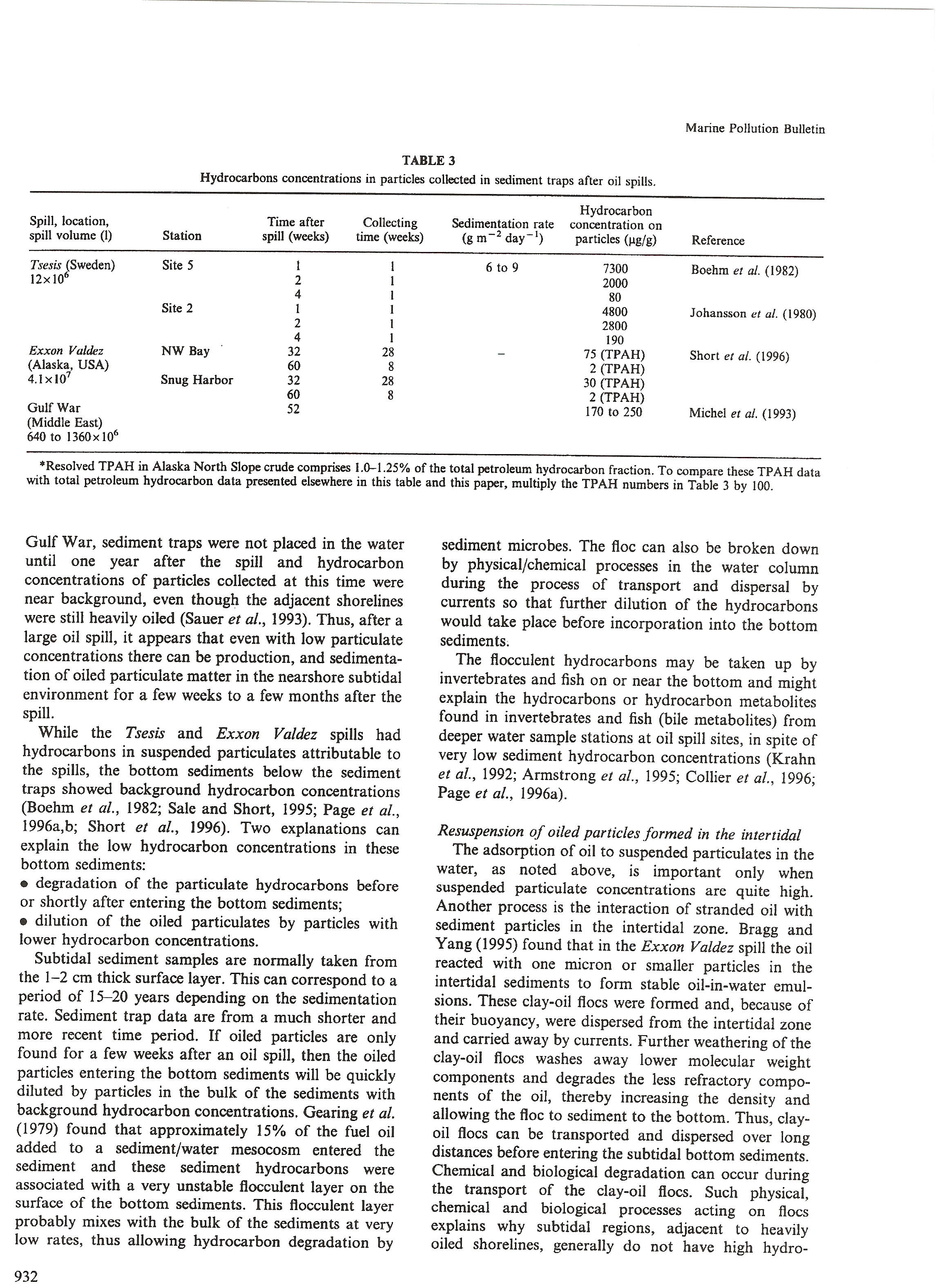55750 scan0026 (4)

Marinę Pollution Bulletin
TABLE 3
Hydrocarbons concentrations in particles collected in sediment traps after oil spills.
|
Spili, location, spili volume (1) |
Station |
Time after spili (weeks) |
Collecting time (weeks) |
Sedimentation ratę (gm_2day_I) |
Hydrocarbon concentration on particles (pg/g) |
Reference |
|
Tsesis (Sweden) |
Site 5 |
1 |
i |
6 to 9 |
7300 |
Boehm et al. (1982) |
|
12x10” |
2 |
i |
2000 | |||
|
4 |
i |
80 | ||||
|
Site 2 |
1 |
i |
4800 |
Johansson et al. (1980) | ||
|
2 |
i |
2800 | ||||
|
4 |
i |
190 | ||||
|
Exxon Valdez |
NWBay |
32 |
28 |
- |
75 (TPAH) |
Short et al. (1996) |
|
(Alaska, USA) |
60 |
8 |
2 (TPAH) | |||
|
4.1 x 107 |
Snug Harbor |
32 |
28 |
30 (TPAH) | ||
|
60 |
8 |
2 (TPAH) | ||||
|
Gulf War |
52 |
170 to 250 |
Michel et al. (1993) | |||
|
(Middle East) | ||||||
|
640 to 1360xl06 |
*Resolved TPAH in Alaska North Slope crude comprises 1.0-1.25% of the total petroleum hydrocarbon fraction. To compare tbese TPAH data with total petroleum hydrocarbon data presented elsewhere in this table and this paper, multiply the TPAH numbers in Table 3 by 100.
Gulf War, sediment traps were not placed in the water until one year after the spili and hydrocarbon concentrations of particles collected at this time were near background, even though the adjacent shorelines were still heavily oiled (Sauer et al., 1993). Thus, after a large oil spili, it appears that even with Iow particulate concentrations there can be production, and sedimenta-tion of oiled particulate matter in the nearshore subtidal environment for a few weeks to a few months after the spili.
While the Tsesis and Exxon Valdez spills had hydrocarbons in suspended particulates attributable to the spills, the bottom sediments below the sediment traps showed background hydrocarbon concentrations (Boehm et al., 1982; Sale and Short, 1995; Page et al., 1996a,b; Short et al., 1996). Two explanations can explain the Iow hydrocarbon concentrations in these bottom sediments:
• degradation of the particulate hydrocarbons before or shortly after entering the bottom sediments;
• dilution of the oiled particulates by particles with lower hydrocarbon concentrations.
Subtidal sediment samples are normally taken from the 1-2 cm thick surface layer. This can correspond to a period of 15-20 years depending on the sedimentation ratę. Sediment trap data are from a much shorter and morę recent time period. If oiled particles are only found for a few weeks after an oil spili, then the oiled particles entering the bottom sediments will be ąuickly diluted by particles in the bulk of the sediments with background hydrocarbon concentrations. Gearing et al. (1979) found that approximate!y 15% of the fuel oil added to a sediment/water mesocosm entered the sediment and these sediment hydrocarbons were associated with a very unstable flocculent layer on the surface of the bottom sediments. This flocculent layer probably mixes with the bulk of the sediments at very Iow rates, thus allowing hydrocarbon degradation by sediment microbes. The floc can also be broken down by physical/chemical processes in the water column during the process of transport and dispersal by currents so that further dilution of the hydrocarbons would take place before incorporation into the bottom sediments.
The flocculent hydrocarbons may be taken up by invertebrates and fish on or near the bottom and might explain the hydrocarbons or hydrocarbon metabolites found in invertebrates and fish (bile metabolites) from deeper water sample stations at oil spili sites, in spite of very Iow sediment hydrocarbon concentrations (Krahn et al., 1992; Armstrong et al., 1995; Collier et al., 1996; Page et al., 1996a).
Resuspension of oiled particles formed in the intertidal
The adsorption of oil to suspended particulates in the water, as noted above, is important only when suspended particulate concentrations are quite high. Another process is the interaction of stranded oil with sediment particles in the intertidal zonę. Bragg and Yang (1995) found that in the Exxon Yaldez spili the oil reacted with one micron or smaller particles in the intertidal sediments to form stable oil-in-water emul-sions. These clay-oil flocs were formed and, because of their buoyancy, were dispersed from the intertidal zonę and carried away by currents. Further weathering of the clay-oil flocs washes away lower molecular weight components and degrades the less refractory compo-nents of the oil, thereby increasing the density and allowing the floc to sediment to the bottom. Thus, clay-oil flocs can be transported and dispersed over long distances before entering the subtidal bottom sediments. Chemical and biological degradation can occur during the transport of the clay-oil flocs. Such physical, Chemical and biological processes acting on flocs explains why subtidal regions, adjacent to heavily oiled shorelines, generally do not have high hydro-
932
Wyszukiwarka
Podobne podstrony:
15846 scan0024 (4) Marinę Pollution Bulletin TABLE2 Concentrations of total petroleum hydrocarbons (
60761 scan0034 (2) Marinę Pollution Bulletin Page, D. S., Foster, J. C., Pickett, P. M. and Gilfilla
18805 scan0030 (2) Marinę Pollulion Bulletin Petroleum hydrocarbons by fish. After metabolism by pha
11465 scan0028 (3) Marinę Pollution Bulletin their metabolites in invertebrates and fish from subtid
scan0022 (5) Pergamon Pil: S0025-326X(97)00078-7 Marinę Pollution Bulletin, Vol. 34, No. II, pp. 928
43959 scan0032 (4) Marinę Pollution BuUetin histopathology of fish, increases in opportunistic speci
00110 j0536f1d3dde674795a26861d044a40 110 McWilliams Table 2 are madę. In the case of sampling by a
Fig. 3. Behavior of CO and C02 conceniration in the stack gases as a function of stoichiometric raii
A Water table FIGURĘ 11.4 (A) In this natural system, the stream drains water from the region—not on
więcej podobnych podstron